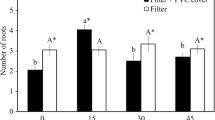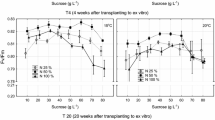Abstract
This paper reports on the fast fluorescence responses of Gardenia jasminoides Ellis plantlets, at two successive stages (shoot multiplication and root induction) of culture in vitro. We test whether plantlets in vitro suffer photoinhibition during culture and whether the degree of photoautotrophy of these mixotrophic plantlets has any effect on the extent of photoinhibitory impairment. In this regard the effects of different sucrose levels in the medium and PPFD during growth on the development of photoautotrophy and the extent of photoinhibition were evaluated. Plantlets were grown under low, intermediate, and high (50, 100, and 300 μmol m-2 s-1) PPFD, and at 3 different sucrose concentrations (0.5, 1.5, and 3.0%, w/v) in the medium, during shoot multiplication. During root induction the same growth conditions were assayed except for the high PPFD. The development of photoautotrophy was assessed via the difference between the stable carbon isotope composition of sucrose used as heterotrophic carbon source and that of leaflets grown in vitro. Plantlets from root induction showed more developed photoautotrophy than those from shoot multiplication. For both stages the low-sucrose medium stimulated the photoautotrophy of plantlets in vitro. In addition, intermediate PPFD induced photoautotrophy during shoot multiplication. For plantlets of both culture stages at the lowest PPFD no photoinhibition occurred irrespective of the sucrose concentration in media. However, during the shoot multiplication stage chlorophyll fluorescence measurements showed a decrease in F v /F m and in t 1/2 as growing PPFD increased, indicating photoinhibitory damage. The decline of F v /F m was caused mostly by an increase in F o , indicating the inactivation of PSII reaction centers. However plantlets growing under low sucrose showed reduced susceptibility to photoinhibition. During root induction, only plantlets cultured with high sucrose showed a decrease in F v /F m as PPFD increased, although t 1/2 remained unchanged. In this case, the decline of F v /F m was mostly due to a decrease in F m , which indicates increased photoprotection rather than occurrence of photodamage. Therefore, growth in low-sucrose media had a protective effect on the resistance of PSII to light stress. In addition, plantlets were more resistant to photoinhibition during root induction than during shoot multiplication. Results suggest that increased photoautotrophy of plantlets reduces susceptibility to photoinhibition during gardenia culture in vitro.
Similar content being viewed by others
Abbreviations
- AP:
-
apparent photosynthesis
- Chl:
-
total chlorophyll content
- Chl a/b :
-
chlorophyll a-to-b ratio
- Chl/Car:
-
total chlorophyll-to-carotenoids ratio
- δ13C:
-
ratio of 13C/12C relative to PeeDee belemnite standard
- F m :
-
maximum chlorophyll fluorescence
- F o :
-
fluorescence emission when all reaction centres are open and the photochemical quenching is minimal
- F v :
-
variable chlorophyll fluorescence (F m -F o )
- F v /F m :
-
the ratio of variable to maximum chlorophyll fluorescence, indicator photochemical efficiency of PSII
- MS medium:
-
Murashige and Skoog (1962) medium
- PPFD:
-
photosynthetic photon flux density
- Rd:
-
dark respiration, t 1/2 the half-time of the increase from F o to F m
- IAA:
-
indole butyric acid
References
Aitken-Christie J, Davies HE, Holland L, Kubota C & Fujiwara K (1992) Effect of nutrient media composition on sugar-free growth and chlorophyll fluorescence of Pinus radiata shoots in vitro. Acta Hortic. 319: 125–130
Anderson JM & Osmond CB (1987) Shade-sun responses: compromises between acclimation and photinhibition. In: Kyle DJ, Osmond CB & Arntzen CJ (eds) Photoinhibition (pp 1–38). Elsevier Science Publishers B. V., Amsterdam
Anderson JM, Chow WS & Goodchild DJ (1988) Thylakoid membrane organization in sun/shade acclimation. In: Evans JR, vonCaemmerer S & AdamsIII WW (eds) Ecology of Photosynthesis in Sun and Shade (pp 11–26). CSIRO, Melbourne
Araus JL, Alegre L, Tapia L & Calafell R (1986a) Relationship between leaf structure and gas exchange in wheat leaves at different insertion levels. J. Exp. Bot. 37: 1323–1333
Araus JL, Alegre L, Tapia L, Calafell R & Serret MD (1986b) Relationships between photosynthetic capacity and leaf structure in several shade plants. Am. J. Bot. 73: 1760–1770
Araus JL & Hogan KP (1994) Comparative leaf structure and patterns of photoinhibition of the neotropical palms Scheelea zonensis and Socratea durissima growing in clearings and forest understory during the dry season in Panama. Am. J. Bot. 81: 726–738
Baker NR & Horton P (1987) Chlorophyll fluorescence quenching during photoinhibition. In: Kyle DJ, Osmond CB & Arntzen CJ (eds) Photoinhibition (pp 145–168). Elsevier Science Publishers B. V., Amsterdam
Björkman O (1986) High-irradiance stress in higher plants and interaction with other stress factors. In: Biggins J (ed) Progress in Photosynthesis Research, Vol 4 (pp 11–18). Martinus Nijhoff, Dordrecht
Björkman O & Demmig B (1987) Photon yield of O2 evolution and chlorophyll fluorescence characteristics at 77 K among vascular plants of diverse origins. Planta 170: 489–504
Bolhar-Nordenkampf HR, Long SP, Baker NR, Öquist G, Schreiber U & Lechner EG (1989) Chlorophyll fluorescence as a probe of the photosynthetic competence of leaves in the field: a review of current instrumentation. Funct. Ecol. 3: 497–514
Boyer JS, Armand PA & Sharp RE (1987) Light stress and leaf water relations. In: Kyle DJ, Osmond CB & Arntzen CJ (eds) Photoinhibition (pp 111–122). Elsevier Science Publishers B. V., Amsterdam
Cleland RE, Melis A & Neale PJ (1986) Mechanism of photoinhibition: photochemical reaction center inactivation in system II of chloroplasts. Photosynthesis Res. 9: 79–88
Deléens E, Cliquet JB & Prioul JL (1994) Use of 13C and 15N plant label near natural abundance for monitoring carbon and nitrogen partitioning. Aust. J. Plant Physiol. 2: 133–146
Demmig B & Björkman O (1987) Comparison of the effect of excessive light on chlorophyll fluorescence (77 K) and photon yield of O2 evolution in leaves of higher plants. Planta 171: 171–184
Demming-Adams B, AdamsIII WW, Winter K, Meyer A, Schreiber U, Pereira JS, Krüger A, Czygan F-C & Lange OL (1989) Photochemical efficiency of photosystem II, photon yield of O2 evolution, photosynthetic capacity, and carotenoid composition during the midday depression of net CO2 uptake in Arbutus unedo growing in Portugal. Planta 177: 377–387
DeRiek J, VanCleemput O & Debergh PC (1991) Carbon metabolism of micropropagated Rosa multiflora L. In vitro Cell. Dev. Biol. 27P: 57–63
Dubé SL & Vidaver W (1992) Photosynthetic competence of plantlets grown in vitro. An automated system for measurement of photosynthesis in vitro. Physiol. Plant. 84: 409–416
Farquhar GD, Ehleringer JR & Hubick KT (1989) Carbon isotope discrimination and photosynthesis. Annu. Rev. Plant Physiol. Plant Mol. Biol. 40: 503–537
Fork DC & Satoh K (1986) The control by state transitions of the distribution of excitation energy in photosynthesis. Annu. Rev. Plant Physiol. 37: 335–361
Fujiwara K, Kira S & Kozai T (1992) Time course of CO2 exchange of potato cultures in vitro with different sucrose concentrations in the culture medium. J. Agr. Met. 48: 49–56
Galzy R & Compan D (1992) Remarks on mixotrophic and autotrophic carbon nutrition of Vitis plantlets cultured in vitro. Plant Cell Tiss. Org. Cult. 31: 239–244
Grout BWW & Ashton MJ (1978) Transplanting of cauliflower plants regenerated from meristem culture. II. Carbon dioxide fixation and the development of photosynthetic ability. Hortic. Res. 17: 65–71
Hdider C & Desjardins Y (1994) Effects of sucrose on photosynthesis and phosphoenolpyruvate carboxylase activity of in vitro culture strawberry plantlets. Plant Cell Tiss. Org. Cult. 36: 27–33
Jeong BR, Fujiwara K & Kozai T (1993) Carbon dioxide enrichment in autotrophic micropropagation: methods and advantages. HortTechnology 3: 332–334
Kamaluddin M & Grace J (1992) Photoinhibition and light acclimation in seedlings of Bischofia javanica, a tropical forest tree from Asia. Ann. Bot. 69: 47–52
Kozai T (1991) Micropropagation under photoautotrophic conditions. In: Debergh PC & Zimmerman RH (eds) Micropropagation: Technology and Application (pp 447–469). Kluwer Academic Publ., Dordrecht.
Kozai T, Oki H & Fujiwara K (1990) Photosynthetic characteristics of Cymbidium plantlet in vitro. Plant Cell Tiss. Org. Cult. 22: 205–211
Kozai T, Koyama Y & Watanabe I (1988) Multiplication and rooting of potato plantlets in vitro with sugar-free medium under high photosynthetic photon flux. Acta Hortic. 230: 121–127
Kubota C & Kozai T (1992) Growth and net photosynthetic rate of Solanum tuberosum in vitro under forced and natural ventilation. HortScience 27: 1312–1314
Krause GH (1988) Photoinhibition of photosynthesis. An evaluation of damaging and protective mechanisms. Physiol. Plant. 74: 566–574
Lee N, Wetzstein HY & Sommer H (1985) Effects of quantum flux density on photosynthesis and chloroplast ultrastructure in tissue-cultured plantlets and seedlings of Liquidambar styraciflua L. towards improved acclimatization and field survival. Plant Physiol. 78: 637–641
Lichtenthaler HK (1987) Chlorophylls and carotenoids: pigments of photosynthetic biomembranes. Method. Enzymol. 148: 350–382
Ludlow MM (1987) Light stress at high temperature. In: Kyle DJ, Osmond CB & Arntzen CJ (eds) Photoinhibition (pp 89–110). Elsevier Science Publishers B. V., Amsterdam
Ludlow MM & Björkman O (1984) Paraheliotropic leaf movement in Siratro as a protective mechanism against drought-induced damage to primary photosynthetic reactions: damage by excessive light and heat. Planta 161: 505–518
Murashige T & Skoog F (1962) A revised medium for rapid growth and bioassays with tobacco tissue cultures. Physiol. Plant. 15: 473–497
Ögren E & Öquist G (1985) Effect of drought on photosynthesis, chlorophyll fluorescence and photoinhibition susceptibility in intact willow leaves. Planta 166: 380–388
Öquist G & Wass R (1988) A portable, microprocessor-operated instrument for measuring chlorophyll fluorescence kinetics in stress physiology. Physiol. Plant. 73: 211–217
Osmond CB, Gui-Ying B, Lin-Ke H & Sharkey TD (1987) Determining the role of light and stress effects on photosynthesis. In: Current Topics in Plant Biochemistry and Physiology, Vol 6 (pp 134–146). Interdisciplinary Plant Group, University of Missouri-Columbia, Columbia
Pearcy RW & Sims DA (1994) Photosynthetic acclimation to changing light environments: scaling from the leaf to the whole plant. In: Caldwell MM & Pearcy RW (eds) Exploitation of Environmental Heterogeneity by Plants. Ecophysiological Processes Above- and Belowground (pp 145–174). Academic Press, Inc., San Diego
Peterson RB (1990) Effects of water vapor deficit on photochemical and fluorescence yields in tobacco leaf tissue. Plant Physiol. 92: 608–614
Powles SB (1984) Photoinhibition of photosynthesis induced by visible light. Annu. Rev. Plant Physiol. 35: 15–44
Righetti B, Magnanini E & Rossi F (1993) Photosynthetic carbon dioxide uptake and oxygen accumulation during in vitro culture of Actinidia deliciosa cv Tomuri. Environ. Exp. Bot. 33: 523–528
Serret MD, Trillas MI, Araus JL (1995) The effect of sucrose and light levels on stable carbon isotope composition and photosynthetic pigments of Gardenia leaflets in vitro. In: Carre F & Chagvardieff P (eds) Ecophysiology and photosynthetic in vitro cultures (pp 169–172). CEA Cadarache
Solarova J (1989) Photosynthesis of plant regenerants. Diurnal variation in CO2 concentration in cultivation vessels resulting from plantlets photosynthetic activity. Photosynthetica 23: 100–107
Steward FC (1983) Reflections on Aseptic Culture. In: Evans DA, Sharp WR, Ammirato PV & Yamada Y (eds) Handbook of Plant Cell Culture (pp 1–11). Macmillan Publishers, New York
Thorpe TA & Patel KR (1984) Clonal propagation: adventitious buds. In: Vasil IK (ed) Cell Culture and Somatic Cell Genetics of Plants. Laboratory Procedures and Their Applications, Vol 1 (pp 49–60). Academic Press, Inc., Orlando
Author information
Authors and Affiliations
Rights and permissions
About this article
Cite this article
Serret, M.D., Trillas, M.I., Matas, J. et al. Development of photoautotrophy and photoinhibition of Gardenia jasminoides plantlets during micropropagation. Plant Cell Tiss Organ Cult 45, 1–16 (1996). https://doi.org/10.1007/BF00043422
Received:
Accepted:
Issue Date:
DOI: https://doi.org/10.1007/BF00043422




